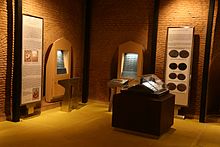| This article possibly contains original research. Please improve it by verifying the claims made and adding inline citations. Statements consisting only of original research should be removed. (July 2019) (Learn how and when to remove this message) |


The state of Punjab is renowned for its cuisine, culture and history. Punjab has a vast public transportation and communication network.
Punjab receives many religious tourists, as the state is home to some of the holiest places in Sikhism, including the Harmandir Sahib and three of the five Panj Takht.
Gobindgarh Fort
Main article: Gobindgarh Fort


Gobindgarh Fort of Maharaja Ranjit Singh at Amritsar is developed as a museum and theme park, as a repository of History of Punjab. It has showcase of Zamzama cannon and Koh-i-Noor diamond replica alongside programs of Whispering Walls Laser show, 7D show and night cultural shows.
Khatkar Kalan
Main article: Khatkar KalanKhatkar Kalan is a village between Banga and Nawanshar towns in Shahid Bhagat Singh Nagar district in the Indian state of Punjab. This is the ancestral place of S.Bhagat Singh, the a well known freedom fighter of India. The district is named after his name, Shaheed Bhagat Singh Nagar.
Neighboring villages sharing a boundary with Katkar Kalan are Thandian, Dosanjh Khurd, Manguwal, Karnana, Kahma, Bhootan, Bhukhari and the town of Banga.
Durgiana Temple
Main article: Durgiana TempleThe Durgiana Temple, Durga Tirath and Sitla Mandir, is a main Hindu temple of Punjab (India) situated in the city of Amritsar. Though a Hindu temple, its architecture is similar to the Golden Temple of Sikh religion. It is named after name of the Goddess Durga, the chief Goddess deified and worshipped here.
Harike wetland
Main article: Harike Wetland
Harike bird sanctuary also known as Hari-ke-Pattan is wetland where lakhs of birds arrive from Siberia, Russia, Kazakhstan and other low temperature regions start arriving at the from mid-October up to December and stay here till March.
Jallianwala Bagh
Jallianwala Bagh is a garden suited In City Amritsar of Punjab. This monument signifies the nation. It was established in 1951. Jallianwala bagh is well known due to the massacre happened in this monument. Jallianwala Bagh Massacre occurred on 13 April 1919, in which thousands of Indians died as General Dyer ordered their army to fire on the innocent Indians.
See also
References
- Polgreen, Lydia (29 August 2010). "A Sikh Temple Where All May Eat, and Pitch In". The New York Times. ISSN 0362-4331. Retrieved 29 July 2019.
- "Yahoo Search - Web Search".
- "Revisiting projects: Bricks of Gobindgarh Fort start pouring out history". 19 February 2017.
- "Gobindgarh Fort phase-I inaugurated".
- Singh, Bhagat; Hooja, Bhupendra (2007), The Jail Notebook and Other Writings, LeftWord Books, pp. 12–13, ISBN 978-81-87496-72-4
- Gaur, I.D. (2008), Martyr as Bridegroom, Anthem Press, pp. 53–55, ISBN 978-1-84331-348-9
- Discover Punjab. Parminder Singh Grover. pp. 28–29. GGKEY:LDGC4W6XWEX.
- "Durgiana Temple (Lakshmi Narain Temple)". National Informatics center.
- "26% less winged guests reached Harike wetland this year". Hindustan Times. 21 January 2020. Retrieved 2 August 2020.
- Sharma, Anil (5 January 2020). "Tourism project at Harike sanctuary: Tree houses, eateries to make wetland tourists' delight". Hindustan Times. Retrieved 2 August 2020.
- "Jallianwala Bagh Amritsar - The Complete Guide | City Amritsar". Holy City Amritsar. 14 July 2019. Retrieved 19 September 2019.